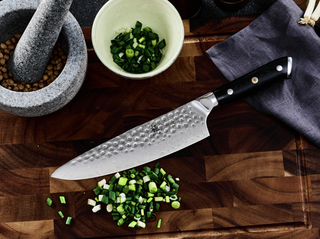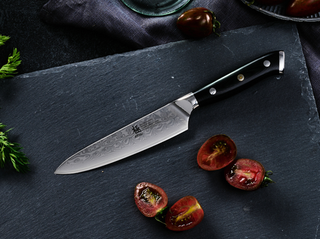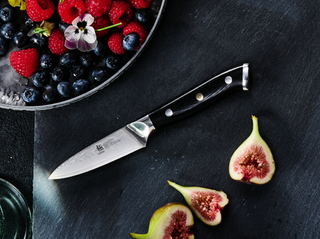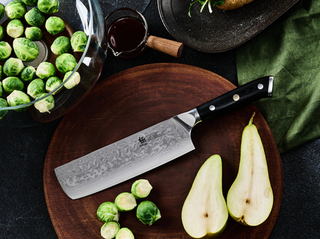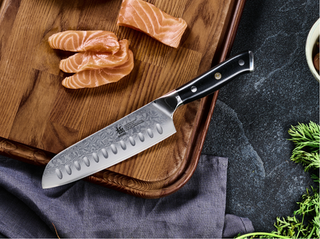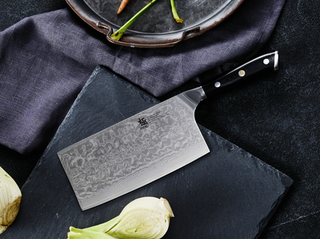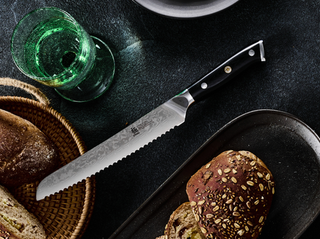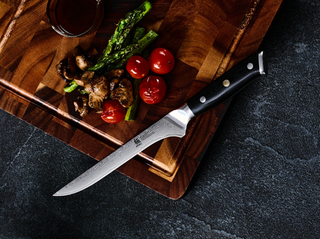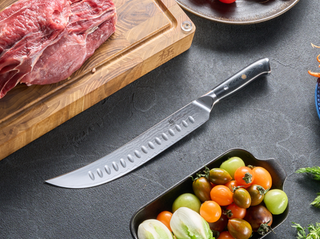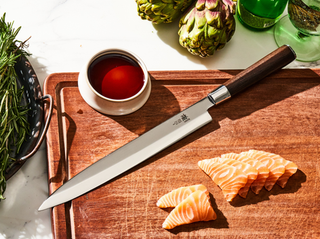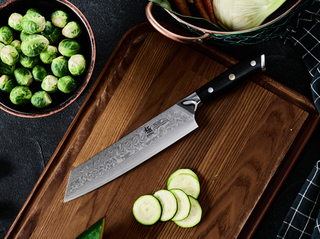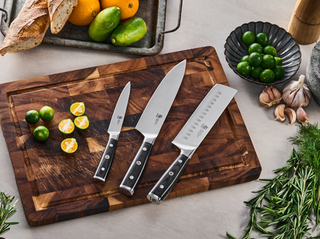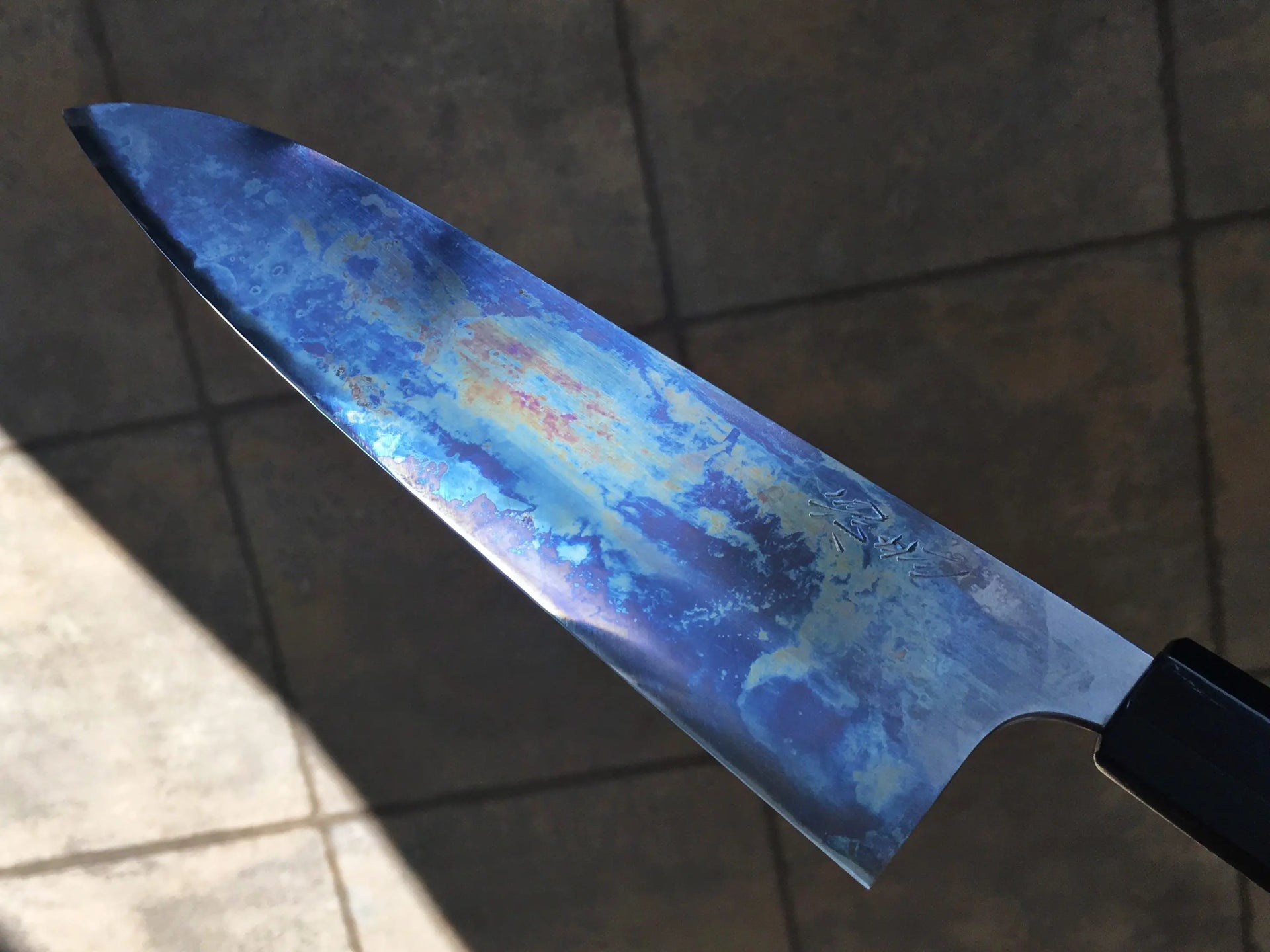The patina on a carbon steel knife is just the good kind of oxidization. It's a little bit like rust except it will actually keep your knife from rusting.
This protective layer forms naturally when your knife reacts with certain foods and the air. It creates beautiful blue, gray, and purple tones that make your knife uniquely yours.
Here are two ideas that can be true at the same time: Patina protects your knife from rust. A well-developed patina adds character and beauty to your blade.
For the uninitiated, a patina is the knife equivalent of breaking in a good pair of jeans or aging a fine whiskey – it gets better with time. While it develops naturally through regular use, you can also force a patina if you're impatient or having issues with your knife rusting.
The Science Behind Patina Formation

When carbon steel with low chromium content meets air and food acids, a chemical reaction occurs on the surface. Unlike stainless steel (which contains at least 12% chromium), traditional Japanese carbon steels can't form a chromium oxide layer to prevent oxidation.
Instead, these knives form iron oxide compounds that create the protective patina. You'll notice this process happening in distinct color stages: first golden yellow, then deep blue, followed by purple, and finally gray that darkens over time.
This color progression is a visual indicator of the oxidation depth. The more developed the patina becomes, the more protection it offers your knife.
Which Knives Develop Patina?
Not all knives develop patina. This natural phenomenon is primarily associated with carbon steel blades that contain minimal chromium.
Modern stainless steel knives (containing at least 12% chromium) generally don't develop patina. The high chromium content forms a different type of protective layer that remains invisible.
Many traditional Japanese kitchen knives are specifically designed to develop beautiful patina. Popular types include White Steel (Shirogami), Blue Steel (Aogami), and Swedish steel.
Some Western knife makers are embracing this tradition too, with carbon steel models from makers like K Sabatier and Opinel developing gorgeous patinas that previous generations of chefs would recognize instantly.
How to Identify the Difference Between Healthy Patina and Harmful Rust

Patina is smooth, often bluish or gray, and doesn't damage your knife. Rust is orange-brown, rough to the touch, and will actually eat into your blade if left unchecked.
A healthy patina won't rub off easily, while surface rust will flake away and leave more exposed steel. If you see orange spots that feel rough or pitted, that's rust – not patina.
I've found that patina tends to have a slight iridescence when held at certain angles, while rust always looks dull and grainy. This visual difference becomes obvious once you've seen both on your knife.
The simple finger test rarely fails: run your finger gently along the blade. If it feels smooth, it's patina. If it feels rough or grainy, you're dealing with rust and should address it immediately.
Patina Development Stages

Patina formation follows a predictable color progression that helps you identify its stage of development:
- New Exposure (0-30 minutes): Golden yellow tones appear where the steel first reacts with food acids or forcing agents
- Early Development (1-2 hours): Deep blues emerge, often in beautiful patterns where air meets moisture
- Middle Stage (2-24 hours): Purple and blue-gray tones dominate, creating the most visually striking appearance
- Mature Patina (Days to weeks): Settles into a stable gray or blue-black that darkens over time with use
The most aesthetically pleasing stage is typically the middle stage with its vibrant blues and purples. Many knife enthusiasts try to maintain this look, though with regular use, it will naturally progress to the mature stage.
Why Patina Is Actually Good for Your Knife
The patina on your carbon steel knife is stupidly beneficial. It creates a barrier that protects the underlying metal from moisture and oxygen, preventing the formation of harmful rust.
A knife with well-developed patina requires less obsessive care than a pristine one. You'll still need to keep it dry and clean, but you won't need to panic if you don't wipe it immediately after each cut.
Patina gives your knife visual character and a unique appearance. No two patinas are exactly alike – each reflects the specific foods you cut, your cooking style, and your knife care habits.
This personal signature is one reason many professional chefs prefer carbon steel. The patina is the carbon steel monkey paw: exceptional performance with a side of unique beauty that tells your cooking story.
Chef's Tip: The patina actually improves over time, especially during the first few months of use. A mature patina provides better protection than a new one, which is why the first few weeks of ownership are when your knife is most vulnerable to rust.
How to Develop a Natural Patina on Your Carbon Steel Knife
The most authentic way to develop patina is through normal use. Every time you slice an onion, carve a steak, or dice potatoes, you're contributing to your knife's unique character.
Natural patina develops gradually, telling the story of your cooking journey. This is the carbon steel knife equivalent of earning your stripes – it shows you actually use your knife.
After cutting acidic or protein-rich foods, leave the juices on the blade for a few extra minutes before washing. This extra time allows the patina to develop more quickly without risking harmful rust.
I've found that slicing hot proteins right after cooking creates the most striking blue patinas on my carbon steel knives. The trick is finding the balance between letting the patina develop and not letting your knife sit dirty for too long.
What Foods Create the Most Beautiful Patinas
Through years of working with carbon steel knives, I've found certain foods consistently create striking patina patterns:
- Hot Proteins: Freshly cooked beef, chicken, and fish create vibrant blues and purples
- Onions: Create gray-blue patterns with interesting variations
- Citrus Fruits: Produce dark gray areas with distinct boundaries
- Apples: Create subtle golden hues that darken over time
- Coffee Grounds: Develop even, dark patterns that highlight knife geometry
The combination of these foods over time creates the most complex and beautiful patinas. A knife used for a variety of tasks will develop more interesting patterns than one used for just one type of food.
Force a Patina: Practical Guide to Protective Finishes
If your knife is extremely reactive or you want immediate protection, forcing a patina makes sense. Some carbon steel knives will rust if you so much as look at them wrong – these definitely benefit from a forced patina right away.
Forcing a patina can be a fun science experiment and a way to customize your knife's appearance. With the right techniques, you can create everything from solid blue-black finishes to dynamic patterns.
The era of worrying about your knife is over once you've established a good protective patina. This is the carbon steel knife monkey paw: beautiful performance with a small time investment up front.
Chef's Tip: Before forcing any patina, thoroughly clean your knife with hot soapy water to remove any factory oils or residues. For new knives, you might need paint thinner or acetone to remove protective coatings.
How to Force a Patina on a Carbon Steel Knife with Household Items
Here are the top methods for forcing a patina, ranked from most effective to least:
1. The Hot Protein Method (Best for Blue Patinas)
-
Cook a chicken breast or cheap steak until just done.
-
Slice the meat with your knife, allowing the hot juices to coat the blade.
-
Let the juices sit on the blade for 10-20 minutes.
-
Rinse thoroughly with warm water and dry completely.
This method consistently produces beautiful blue-purple patinas that look like they developed naturally. The proteins in hot meat react quickly with carbon steel, creating that coveted color with minimal effort.
2. The Coffee Method (Best for Even, Dark Patinas)
-
Brew a pot of extremely strong coffee (instant coffee works best).
-
Place your knife in the coffee, fully submerged.
-
Let it sit for 24 hours.
-
Rinse thoroughly with warm water and dry completely.
The coffee method produces a very even, dark gray to black patina. This method takes longer but requires zero babysitting – perfect for busy people who just want protection without the fuss.
3. The Boiling Vinegar Method (Best for Rapid Results)
-
Heat white vinegar until just under boiling.
-
Dip your knife for 30 seconds, then remove and let air dry for 30 seconds.
-
Repeat 3-4 times until you reach your desired color.
-
Rinse thoroughly with warm water and dry completely.
This method works incredibly fast and creates blues and browns with interesting patterns. I've found that swishing the knife gently during dips helps avoid bubble marks in the patina.
4. The Cola Method (Best Quick Alternative to Coffee)
-
Pour Coca-Cola into a container large enough for your knife.
-
Submerge your knife completely.
-
Let sit for 60 minutes.
-
Rinse thoroughly with warm water and dry completely.
The cola method produces similar results to the coffee method but in a fraction of the time. This is my go-to method when I need decent results without waiting overnight.
Warning: Never use drain cleaner or other harsh chemicals not intended for food contact. These can pit your blade and create unsafe conditions for food preparation.
What Japanese Knife Makers Say About Patina: Traditional Perspectives
Japanese knife makers often view patina as part of the knife's journey with its owner. Traditional Japanese carbon steel blades like the Shimo line are designed with patina development in mind.
In Japan, a well-developed patina is seen as a sign that a knife is being used properly and cared for correctly. Just as Japanese denim is prized for its unique fading patterns, Japanese knives are valued for their unique patinas.
The natural evolution of a knife's appearance reflects the wabi-sabi philosophy – finding beauty in imperfection and transience. Your knife's patina tells a story that mass-produced stainless steel knives simply cannot.
When I visited a knife shop in Tokyo, the master sharpener showed me his 40-year-old carbon steel knife with a patina so deep and complex it looked like a galaxy. "Each mark is a meal I have prepared," he told me with obvious pride.
Why Some People Remove Patina and How to Do It Safely
Some knife enthusiasts prefer to "reset" their patina occasionally to start fresh. Others might want to remove unwanted patina patterns or spots that developed unevenly.
Removing patina doesn't damage your knife when done correctly. Think of it as pressing reset on your knife's appearance – you're not harming it, just giving yourself a clean canvas.
The baking soda method is the gentlest and safest way to remove patina without scratching your blade. It's the perfect balance between effectiveness and preserving your knife's finish.
How to Remove Patina from Carbon Steel Knife Without Damaging It
-
Make a thick paste with baking soda and a small amount of water.
-
Apply the paste to the areas where you want to remove the patina.
-
Gently rub in small circles with your finger or a soft cloth.
-
Rinse thoroughly and dry completely.
For more stubborn patina, you can use Barkeeper's Friend, which contains oxalic acid derived from rhubarb. Just be aware that stronger cleaners may remove more of your knife's finish along with the patina.
3 Essential Questions to Ask Before Developing Patina on Your Knife
-
How will you use your knife most often? If you'll be cutting lots of acidic foods, a forced patina provides better protection than waiting for natural development.
-
What aesthetic are you hoping to achieve? Different methods create dramatically different looks – from solid blue-black to vibrant, swirling patterns.
-
How much maintenance are you willing to perform? Natural patinas develop unevenly and may require occasional touch-ups, while forced patinas can provide more consistent protection immediately.
Be honest about your habits and preferences. The best patina method is the one that fits how you actually cook – not how you wish you cooked.
Frequently Asked Questions About Carbon Steel Knife Patina
Is knife patina safe for food preparation?
Yes, patina is completely food-safe. It's simply a stable layer of oxidation that actually helps protect your knife. Unlike rust, patina doesn't flake off into your food and is chemically stable.
How do I maintain a knife with patina?
Simply wash and dry your knife after each use. The patina will continue to develop and evolve naturally. Avoid harsh detergents or scrubbing with abrasives unless you're intentionally removing the patina.
Will patina affect the sharpness of my knife?
No, patina has no effect on the cutting edge or the knife's performance. If anything, it protects the knife body while letting the edge do its work unaffected.
How do I know if my carbon steel knife has rust instead of patina?
Rust is orange-brown and feels rough to the touch. If you can scrape it off easily with your fingernail and it leaves a mark or pit, it's rust. Patina is typically blue-gray-black and smooth to the touch.
Can I still use my carbon steel knife for acidic foods after it has patina?
Yes! The patina actually provides some protection against reactive foods. You'll still want to clean your knife promptly after cutting acidic ingredients, but the reaction won't be as immediate or dramatic.
Does coffee patina provide better protection than mustard patina?
Coffee generally provides more even and complete protection. Mustard patinas can be spotty and are better for creating patterns than full protection. For best rust prevention, coffee, vinegar, or hot protein methods are superior.
How often should I renew the patina on my carbon steel knife?
Most patinas don't need renewal – they continue to develop and strengthen with use. If your patina is wearing thin in spots after months of use, you can touch up just those areas using any of the forcing methods.
How do you remove rust from a carbon steel knife?
For light surface rust, use a paste of baking soda and water with a soft cloth. For more stubborn rust, a fine metal polish designed for knives or very fine grit sandpaper (1000 grit or higher) can work, followed by proper oiling and re-establishing a patina.
Conclusion
Patina is what makes each carbon steel knife a unique reflection of its owner. No two knives will ever develop the same patterns or colors – it's your cooking story etched into metal.
The process of developing patina is part of the carbon steel experience. It's a small trade-off that delivers a knife with soul, character, and history – something most mass-produced tools completely lack.
Further Reading:
Carbon Steel vs Stainless Steel Knives
What Makes VG10 Steel Worth Considering
How to Choose A Non-toxic Cutting Board
